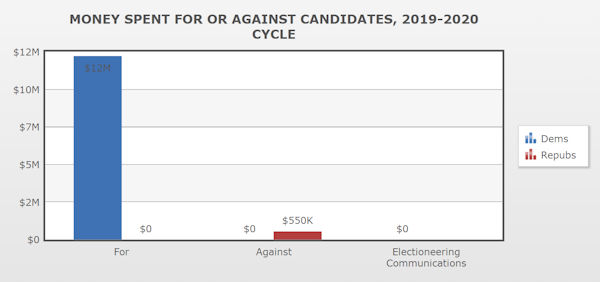SEJournal Online is the digital news magazine of the Society of Environmental Journalists. Learn more about SEJournal Online, including submission, subscription and advertising information.
 |
| Above, a chart showing $12.5 million in campaign spending in the current election cycle by the NextGen Climate Action Committee, a Super PAC created by activist billionaire Tom Steyer. Image: OpenSecrets.org. Click to enlarge. |
Reporter’s Toolbox: Climate Money Meets the Super PACs
By Joseph A. Davis
This fall’s slew of furious election campaigns — at all levels — is unleashing an unprecedented tranche of money from industry and environmental groups. The surprise may be that Big Oil is finally challenged by Big Climate.
For environment reporters covering state or even local races with climate impacts, following the money is still one of the surest ways to illuminate how candidates will vote on the many climate-related decisions they are sure to face if they make it into office.
If you are looking at presidential campaigns, you may have a simpler time finding contribution data. And if you’re looking at state and local races that bring out green or brown money, the same basic data sources may help you there as well.
Where the data comes from
Following that money is not always easy. So here are some sturdy and versatile tools to help.
- Federal Election Commission: Federal election law obligates candidates and organizations to file reports about the money that flows in politics. The FEC generally requires them to file quarterly and then makes public oceans of data from those reports. That means the FEC website is one of the first places to search.
- Center for Responsive Politics: Fortunately, the Center for Responsive Politics digests, massages and augments that FEC data in ways that make it even more useful for reporting on money in environmental politics. Its OpenSecrets website is a great first stop.
- National Institute on Money in Politics: One additional key source for state and local races is FollowTheMoney.org — the nifty and user-friendly data website of the National Institute on Money in Politics. It includes state-level races that are not covered by federal election law.
How to use the data smartly
Fossil fuel industries are just some of the interest groups engaged in environmental politics. You may need to look at utilities (electric and water), agriculture, forest products, chemicals, mining and smelting, fisheries, manufacturing and more.
But with climate change dominating many elections as a key issue, fossil fuel industries like coal, oil and gas deserve special attention.
Look, for example, at OpenSecrets’ list of top oil and gas industry contributors. Koch Industries not surprisingly holds second place.
The bottom line is the
emergence of what you might call
Big Green or Big Climate.
But note that Energy Transfer Equity holds first place with more than $13 million in contributions. Those are the people who brought you the embattled Dakota Access Pipeline (along with other pipelines).
Recently its CEO, Kelcy Warren, donated a princely $10 million to a pro-Trump super PAC.
Such super PACs avoid donation limits via the technicality of not “coordinating” with a candidate. That largesse, along with other fundraising, may make him Trump’s largest donor.
‘Big Climate’ a comer
But it’s not just fossil fuel companies with money in politics these days. As Lisa Friedman reported in the New York Times, climate-driven donors have pumped $15 million-plus (may require subscription) to Democratic presidential candidate Joe Biden.
That may not be as big as the fossil fuel industries’ massive contributions, but it is still big. Friedman pointed to some comparatively new groups bringing climate donors to Biden: GiveGreen, its Climate Leaders for Biden fund and Clean Energy for Biden.
Those efforts come on top of some of the longstanding environmental action groups that donate to campaigns at all levels.
The League of Conservation Voters has been a powerhouse for decades. But many others are large and active as well: Environment America, the NRDC Action Fund, EDF Action and the Sierra Club Political Committee (which actually represents a constellation of state and local chapters).
Then there is the NextGen Climate Action Committee, a creation of activist billionaire Tom Steyer. You can find a lot more environmental PACs on the OpenSecrets site.
The bottom line is the emergence of what you might call Big Green or Big Climate. Since major court decisions in 2010, we have seen the rise of “Super PACs” — that is, political action committees that can receive contributions that are unrestricted in size.
And green groups, after years of adjustment and growth, have become major players in this game just as many oil and gas companies are scraping for money as the market for their products declines.
Joseph A. Davis is a freelance writer/editor in Washington, D.C. who has been writing about the environment since 1976. He writes SEJournal Online's TipSheet, Reporter's Toolbox and Issue Backgrounder, as well as compiling SEJ's weekday news headlines service EJToday. Davis also directs SEJ's Freedom of Information Project and writes the WatchDog opinion column and WatchDog Alert.
* From the weekly news magazine SEJournal Online, Vol. 5, No. 38. Content from each new issue of SEJournal Online is available to the public via the SEJournal Online main page. Subscribe to the e-newsletter here. And see past issues of the SEJournal archived here.














 Advertisement
Advertisement 



